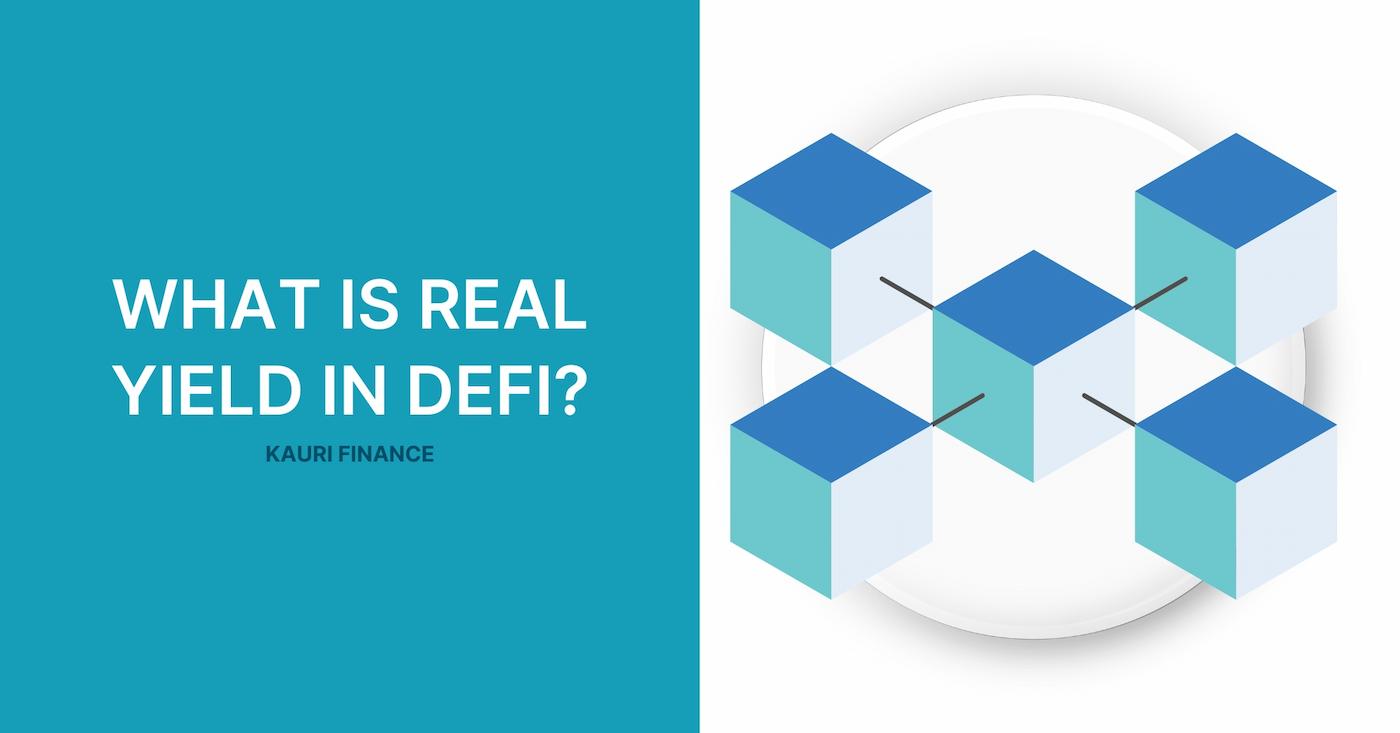
What is Real Yield in DeFi?

Decentralized finance, known as DeFi, has left an indelible mark on the blockchain industry by offering an alternative to traditional banking services. The sector has caught the attention of investors and developers alike due to the ability to invest and utilize financial products outside of the established financial system. In particular, the high levels of returns available in DeFi are made possible by innovative income farming strategies based on the use of sophisticated algorithms and incentives to attract liquidity.
However, it is important to realize that returns in DeFi can vary widely and are not always sustainable. This article will explore the concept of real yield in DeFi and why it is key to its long-term sustainability and development.
What is DeFi Yield?
DeFi yield - is the interest rate or return on investment that users earn by participating in various decentralized finance protocols. This can include interest for providing liquidity, staking rewards, and other forms of active participation in the DeFi ecosystem.
Main ways to generate yield:
- Yield Farming: Participants lock their assets into the protocol to receive rewards in the form of additional tokens.
- Liquidity Provisioning: Investors provide their cryptocurrencies in exchange for a share of transaction fees to the liquidity pool.
- Staking: Freezing tokens on the blockchain to support network operations and receiving rewards for doing so.
The concept of yield farming:
Yield farming or "liquid mining" - is the process of earning additional tokens by participating in decentralized finance activities, such as providing liquidity to exchange pools or participating in a staking program.
Popular methods of farming yield in DeFi:
- Flash Loans: Loans without collateral that must be repaid within a single blockchain transaction.
- Automated Market Makers (AMMs): Providing assets to AMMs to receive a portion of transaction fees.
- Liquidity Pools: Investing cryptocurrencies in liquidity pools to enable trading on decentralized exchanges and receive a share of commissions.
These methods allow members of the DeFi ecosystem to generate income on their cryptocurrency assets, providing new opportunities for investment and speculation in decentralized finance.
How does Yield Farming work?
Yield Farming in DeFi is a key mechanism for generating revenue for participants in the ecosystem. The process begins with users contributing their assets to a decentralized protocol's liquidity pool. These pools are used to enable trading between different cryptocurrencies without the need for a traditional intermediary such as an exchange.
The process of providing liquidity:
When you provide liquidity, you are actually contributing a pair of tokens to a pool that is used to execute trade orders on decentralized financial platforms. Depending on the protocol, this could be a pair of stablecoin and cryptocurrency or two different cryptocurrencies. In return for providing your assets, you receive liquidity pool tokens that represent your share in the pool.
Practical Application Examples:
Suppose you want to participate in yield farming on a platform that allows users to trade between ETH and DAI. You deposit equal amounts of ETH and DAI into a liquidity pool. In exchange, the protocol gives you LP (Liquidity Provider) tokens that represent your share of the pool.
When other users exchange between ETH and DAI through the pool, they pay a transaction fee. These commissions are distributed among all liquidity providers in proportion to their share in the pool. Thus, the larger the trading volume through the pool, the higher the profitability for liquidity providers.
Reward Calculation:
The reward amount for yield farming participants depends on several factors, including the total trading volume in the liquidity pool, the amount of assets you have contributed, and additional incentives from the DeFi protocol itself, such as the distribution of management tokens. For example, if the protocol offers additional tokens for participating in the liquidity pool, this can significantly increase the total return on your contribution.
It is important to note that yield farming is not without risks, such as volatility in the exchange rate of the invested assets and potential vulnerabilities in the code of smart contracts. Therefore, before participating in any yield farming transactions, it is important to carefully assess all risks and potential rewards.
Why does DeFi offer high returns?
One of the key features of DeFi is the ability to generate high returns for ecosystem members. This is made possible by several factors that influence the level of yield offered.
Factors to ensure high returns:
- Low operational costs: Unlike traditional financial institutions, DeFi protocols run on blockchain, which minimizes operational costs. Saving on costs allows protocols to offer higher returns to users.
- Efficient capital allocation: Blockchain and smart contracts allow DeFi protocols to efficiently allocate capital among participants, increasing return on investment.
- Management tokens: Many DeFi protocols use management tokens to incentivize participation in the ecosystem. Tokens can provide additional revenue in the form of dividends from protocol profits or the ability to participate in protocol governance votes.
The impact of governance tokens and capital allocation:
- Governance tokens as a reward tool: The introduction of governance tokens into the DeFi ecosystem allows users to not only participate in the governance of the protocol, but also earn passive income. This creates an additional incentive to retain and utilize the tokens, maintaining their value.
- Capital efficiency: Decentralized finance allows capital to circulate more freely and efficiently than in a traditional financial system. This increases the overall profitability of the system, making investment in DeFi attractive to a wide range of investors.
It is important to realize that high returns in DeFi also come with high risks. Fluctuations in the value of cryptocurrencies, possible vulnerabilities in the code of smart contracts and regulatory risks should all be considered before investing in DeFi projects.
What is Real Yield in DeFi?
Real Yield in decentralized finance (DeFi) is different from the usual concept of yield offered by most DeFi protocols. It is a concept that has recently attracted more and more attention in the DeFi community due to its sustainability and long-term perspective.
The difference between real and unreal returns:
- Real yield: is based on actual protocol revenues, such as transaction fees, that are generated naturally as part of economic activity within the ecosystem. This means that the revenue generated by users does not depend on the issuance of new tokens or other forms of inflation of the protocol's own tokens.
- Unrealistic returns: often associated with high returns achieved through the issuance of new tokens or other incentives that may not have a sustainable economic base and lead to token inflation.
Examples of DeFi protocols that offer real returns:
- GMX: This is a decentralized exchange that offers users the ability to make money on their assets by providing liquidity. GMX uses a portion of trading commissions to pay returns to its users, which is an example of real returns.
- Synthetix: This DeFi protocol allows users to create and trade synthetic assets. Synthetix distributes a portion of the commissions from trading synthetic assets to users providing liquidity, thus providing real returns.
- Dopex: This is a decentralized options trading platform that offers investors income from fees for using the platform. The revenue is distributed to DPX token holders and is an example of real returns.
Kauri Finance's role in the DeFi World
Kauri Finance, version 3.0 for personal users on iOS and Web, promises to surpass traditional banking apps with ease of use. This launch highlights Kauri Finance's unique approach to combining decentralized fund storage for added security with centralized banking services for everyday use.
What's unique about Kauri Finance?
- Web3 non-custodial wallet: Kauri offers exclusive control over assets through a non-custodial wallet, providing a high level of security and ease of use. Only the user has access to their crypto assets, making the deposit process more secure.
- Mastercard-enabled cards: Kauri payment cards integrated with Apple or Google Pay make using cryptocurrency as easy as regular cash, emphasizing the crypto-friendly nature of the platform.
- Apps for Web and Mobile Devices: Intuitive, simple and secure interface offering the best of classic banking apps.
- Favorable terms for high-level services: Kauri aims to offer some of the lowest fees on the market, especially through its Web3 wallet, where basic transactions are charged no more than blockchain fees.
Features and Services:
- Swap: Simplifying cryptocurrency exchanges through a universal order of transactions.
- Web3 Passport: A business tool to delineate roles in a company and simplify wallet transactions.
- EUR and USD Accounts: Support for SWIFT, SEPA Instant transfers.
Why choose Kauri.
- Trust and Security: Kauri Finance has been licensed in the EU since 2018 and is backed by advanced security measures, including a 2023 renewed Estonian digital exchange license, Mastercard-validated card security, and PCI DSS certification.
Kauri Finance not only offers tools to conveniently use cryptocurrencies in everyday life, but also actively supports the development of the DeFi ecosystem by providing educational resources and safe investment tools. With Kauri Finance, users can easily integrate into the DeFi world through an intuitive service.
